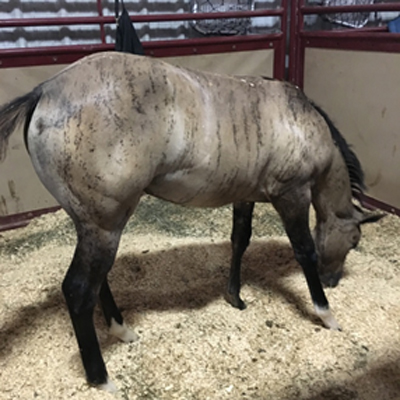

What is Dun Factor?
Dun Factor are the primitive markings a horse can have. The American Buckskin Registry Association actually has a score sheet for us judges to fill out when we judge the Dun Factor Class. Here is the score sheet we use which gives points for particular areas of dun factor. As a breeder I breed for Dun Factor. As a Carded ABRA judge I am familiar with this form. Please note the ABRA takes off for white. The International Buckskin Registry Association, however, does not take off for white. Here are the criteria and examples of dun factor.
Examples of Dun Factor using some of our stallions and mares:
Face Masking & Cob webbing
This picture is of our stallion, Mark Me Famous showing his face masking across his nose, and the cob webbing on his forehead. Face masking is a darker area over the bridge of the nose. Cob webbing are stripe like and looks like spider webs on their forehead. It can be of many types, but should show definite lines and contrast. Mark Me Famous won the IBHA World Show in Dun Factor, and as you will see he has an extreme amount of Dun Factor sometimes referred to as primitive markings.
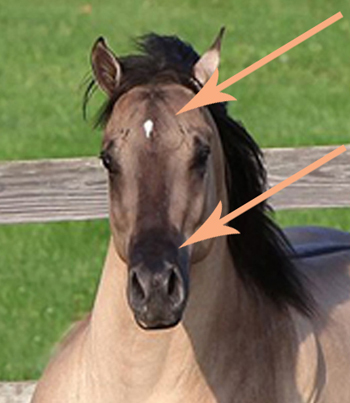
This is our stallion Hollywood Glo Cody and it shows an example of his dark face mask and dark contrast on the back of his ears.
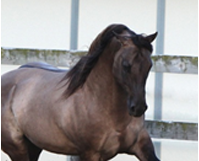
Ear Frames
Ear frames is the dark color on the back of the ears - it can be horizontal barring. It normally goes from the top down to and can be partial or half the ear. Ear tips should show contrast to the body coat and framing and horizontal barring on the backs of the ears is desirable.
This picture is of our Stallion Hollywood Glo Cody which shows the dark contrast on the back of his ears.

This picture is of our stallion Mark Me Famous showing the dark contrast on the back of his ears.
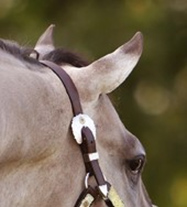
Neck Markings
Stripes and patches on the horses neck. Should show definition and contrast and may be single or in combination.
This picture is of our stallion Mark Me Famous showing the patches on his neck/withers.
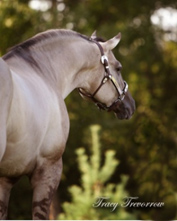
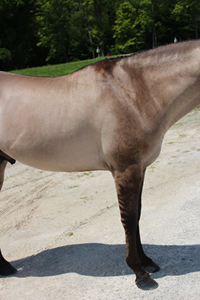
This picture is of our stallion Dunit In Champagne showing the dark patches on his neck.
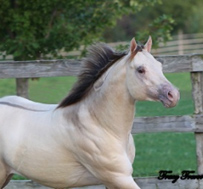
This picture is our mare, Platinum By Design showing her shoulder stripes.
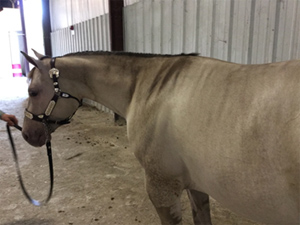
Shoulder Stripe & Rib Barring
Definite contrasting striping over the withers and along rib lines is preferred to cape markings or body coat shadowing.
As you can see in the above photos, both of our stallions have the shoulder stripes. Our Champagne Grullo broodmare, Platinum By Design is the best example of the Shoulder stripe & rib barring as seen below.
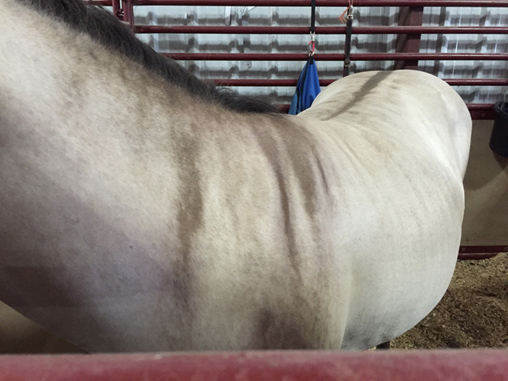
As you can see the "Barbs" run perpendicular to the stripe and seem to run off the dorsal stripe. This is another angle of the same mare.
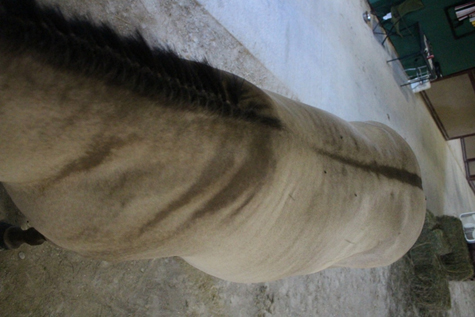
This is our stallion Dunit In Champagne showing the neck & shoulder markings.

Dorsal Stripe
A definite, contrasting stripe running the full length of the back is preferred to a partial stripe of one that represents only a darker hair coat along the backbone. A clearly defined sawtooth dorsal is the most desirable of all. Also the darker & wider the better.
This is a picture of our stallion, Dunit With Champagne.

Leg Barring & Mottling
Horizontal striping on the legs evaluated on the amount of striping and contrast. Diversified blotching may be in conjunction with barring or alone. Scored on the contrast and extent.
Here is close up of our stallion when he was just a few months old. Note the heavy leg barring. Rarely do you ever see this much leg barring on an individual. Most are more like the pictures below.

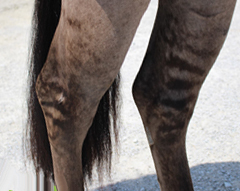
And here is our mare again when she was 2 showing the backs of her legs and below the sides of her legs. She has more mottling than barring.
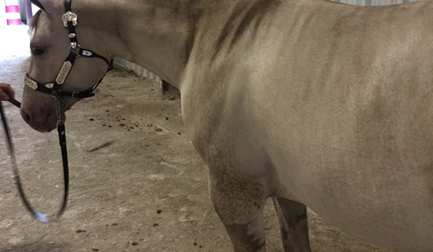
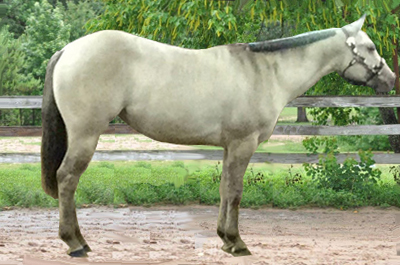
Above are all the things that contribute to judging the Dun Factor Class. Here is some more interesting information.
Some other things you will see on buckskins, duns & grullo's are:
Frosting - It can be found in the mane and is mane hair that is lighter in color or white as shown below:
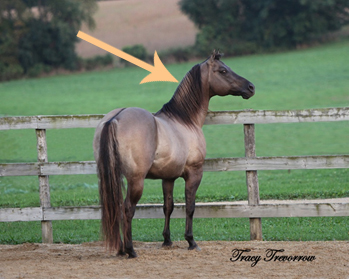
This picture is of our stallion, Hollywood Glo Cody showing the frosting, or lighter color in his mane.
Please note that horses do not have to be in the buckskin family to exhibit frosting as seen here on our Amber Cream Champagne broodmare, Blu Shadow Of Sugar.
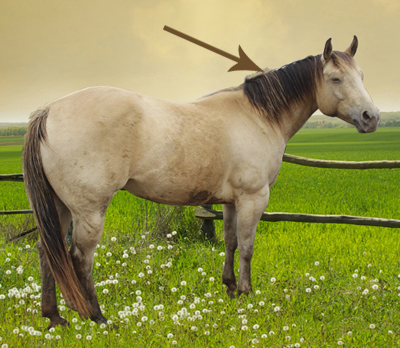
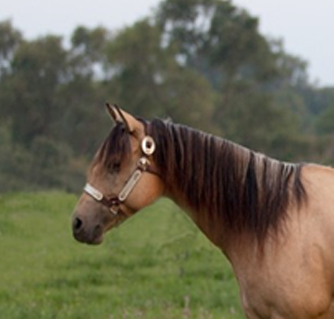
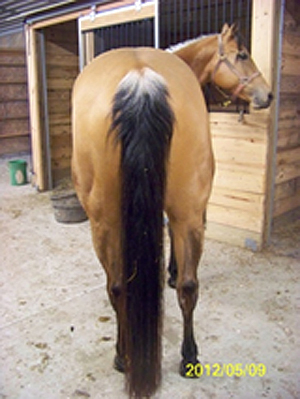
Also keep in mind that coat colors can change due to being sun-bleached, their winter hair verses their summer hair, and even from feeding different supplements to an extent. Here is the same mare towards the end of the summer after being outside in the sun. She was a little older below and therefore more filled out. Also notice she has "dapples" in the picture below.
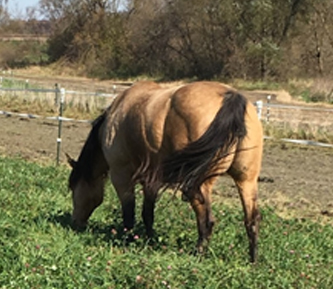
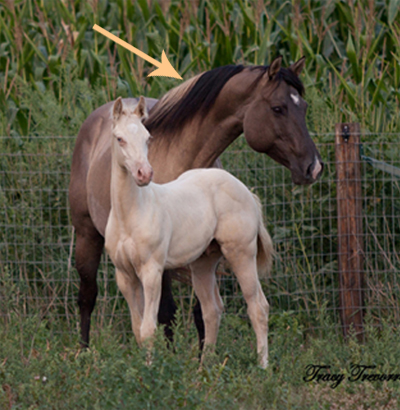
Here are some fun pictures of some of our mares (when they were 2 year olds). Note the 2 to the far right and the one to the far left are all grullo's. The 3rd one from the right is a Classic Champagne which is a black horse with a champagne gene.
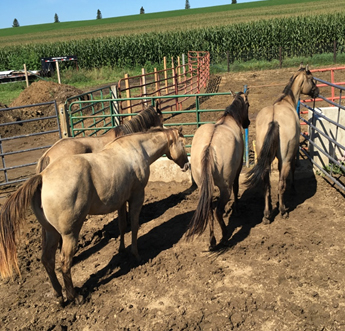
Countershadowing - It is very easy to misunderstand Dun Factor for counter shadowing. Our late stallion One Impressive Beau had a great amount of countershadowing. Here is a picture as an example. The dorsal stripe clearly does not run down into the tail as does the mares in the picture above. Generally the tail is lighter on the sides of where the stripe runs down the tail.
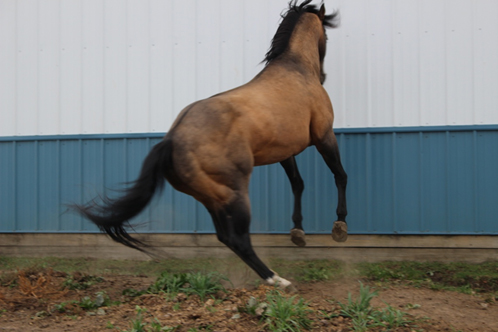
Horse can be born and look one color only to end up another color. Here is a foal born here in 2016 that looked like a grullo - caused by counter-shadowing (pictures of him just a few hours old).
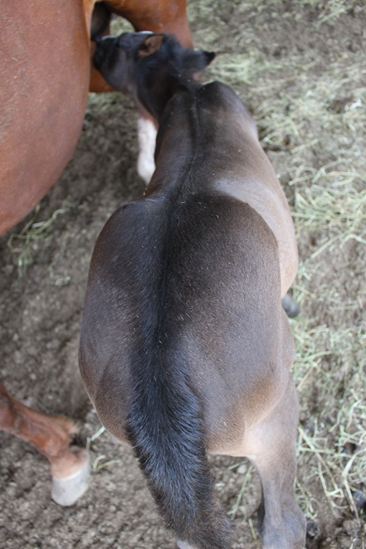
His sire was our buckskin stallion and his dam is a sorrel. You cannot produce a grullo from a Sorrel and a buckskin. This is counter shadowing. Notice the black dorsal stripe does not extend down into the tail. I assumed he would color test a smoky black and the cream gene was influencing the lightness but turns out he color tested as black with no cream. This gorgeous colt is a possible stallion prospect.
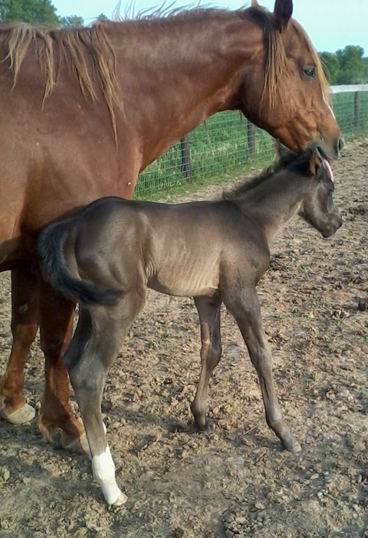
Here are the colors eligible for the American Buckskin Registry Association:
- BUCKSKIN: Body coat some shade of tan, from very light (creme) to very dark (bronze). Points (mane, tail, legs and ear frames) are black or dark brown. Dorsal not required.
- DUN: Body coat some shade of tan, from very light (creme) to a dull or smutty brown (earth tone). Points, dorsal stripe and other dun factor markings are dirty black or smutty brown. There are many shades and variations in the dun color. Dorsal stripe required. Note: The buckskin colored horse with dun factor (dorsal stripe, leg barring, ear frames, shoulder stripes, face masking and cobwebbing) is the ideal color that ABRA was founded to preserve over thirty years ago.
- RED DUN: Body coat a reddish tan without the range of shades as seen in the other dun colors. Mane and tail are red or reddish brown, creme or mixed. The dun factor markings are red or reddish brown. A full, definite dorsal stripe must run the length of the tail.
- GRULLA: (Grew-ya - also called Grullo) A Grulla's body coat is slate colored (bluish gray as the blue heron) from light blue-gray to a brownish shade. Points and dun factor markings are black. A dorsal stripe is required. The Grulla color is the rarest of all horse body coat colors. The word Grulla is Spanish and translates into English as "crane".
Note: There are many variations in the colors and for this reason we insist on eight good colored pictures of each animal to determine eligibility. Many times these horses will be found to have a fringe of cream, dun or grullo colored hairs along the edge of the mane and at the base of the tail. ABRA will not register Paints, Pintos or Appaloosas showing white coat pattern on their bodies, only the solid breeding stock type.
Something totally different, but that can be found in dun horses is Brindle.
- BRINDLE: The brindling pattern found in horses could be described as vertical stripes that are found along the neck, back, hindquarters, and upper legs. The horse's head is usually a solid color and is not affected by the striping. The brindling pattern has no effect on dark points on horses. Some brindle-colored horses are more eye-catching than others.
